Thinking aloud about a Cal 40 reboot turned out to be more “interesting” than we ever imagined.
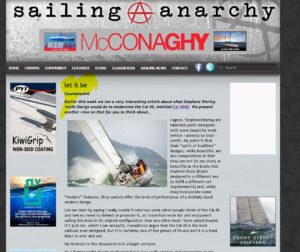
When readers take the time to answer back, it’s time to do some design thinking.
In our last articles, we chatted idly over what we’d thought would be about keeping C. William Lapworth’s legendary pac-racing Cal 40 relevant to today’s materials and techniques. And, oh boy, what a hit. We’re no stranger to strong opinions and hot-bar arguments with this wacky and wonderful sailing tribe of ours. But we were caught out when this Cal 4040 piece instantly became our most popular story, ever. (It never hurts when our friends over at the all-mighty Sailing Anarchy copied and linked to the story. )
Most readers were enthusiastic about our ideas for an updated rig, cleaner cockpit ergonomics and efficient replacement foils for the 40-footer. We even chuckled over the soft-core tongue lashing by a a Cal 40 lover over at Sailing Anarchy , attempting low-level denigration because “why on earth would we do such things” –what a bad idea these upgrades were. And what fun to scan the incoming emails that offered insights as to why — and why not — to tinker with this classic. The Cal 40 is beloved and has a wonderful following. And we share that appreciation to the fullest. So thank you all, for that. You allowed us to dream.
But … if there’s going to be a serious discussion to the practicalities of marine design and engineering on a classic like the Cal 40, well we apologize in advance, but that is sort of what we do. That means we are obliged to step up, and get down, to some serious brass boat-nerd tacks on deep dive project brief on a Cal 40 reboot.
The Design Scuttlebutt on Cal4040
Let’s frame up a scope of work in materials and labor on this refit: a reworked Cal 40 including updated rig, sail inventory, and revisions to cockpit, rudder and keel. Let’s also account for propulsion and interior changes. Because, if you’re going to go down to bare bones on this boat, that is the time to make those always mistakenly-avoided upgrades.
- Rig: Mast/rigging = $50,000-$70,000; Labor = $7,500
- Revised geometry in hoist and boom length.
- Carbon mast, SS rigging, no back stay.
- Square-top main for more efficient horsepower.
- Solent head, Code zero Headsail on outer stay, 105 working jib on inner stay.
- Sails: 3 sails = $20,000 – $30,000
- Sq. top Main, 105 Jib, code zero, A-sail launcher. (That’s all you need, really.)
- Keel: Fin/bulb/structure = $30,000 ; Labor = $10,000
- Not too finicky, yet very efficient updated foil with shorter chord.
- All lead concentrated in bulb.
- Revise structural hull grid for new keel.
- Rudder: Blade/shaft/steering = $12,000; Labor = $5,000
- Again, not too finicky, yet efficient, updated plan form.
- Cockpit and sailing hardware: Materials = $8,000 ; Labor = $30,000
- Fine-tuned for single/dbl-handed racing, some reconstruction required.
- Sheets & halyards lead to helm for sailing with minimal crew.
- Consider: add wheel steering, and definitely an autopilot.
- Interior: Materials = $10,000 ; Labor = $65,000
- Revise layout to remove all unneeded structure. Very light and spare is key.
- Suited for dbl hand racing, no frills.
- Propulsion/systems: Materials = $30,000 ; Labor = $30,000
- Sail drive, 30 hp Volvo or Yanmar.
- Small fridge, with cooktop and galley area.
- Upgraded navigation gear.
- Integrated flywheel genset (IFG)
- Light lithium batteries.
- Paints/soft goods: Materials = $5,500 ; Labor = $7,500
- Design fees: $45,000 – $55,000
The Boat Nerd Brass Tacks.
There is actually some pretty serious offsetting design choices that need to be nailed to make a Cal 40 Reboot worth the trouble. For starters, going to a deeper-draft keel is never a simple decision. When we go deeper, we’re all in agreement that we reduce ballast weight. What does this do? It gives us a lighter boat with similar righting moment. Well, losing weight is good. We also gain the opportunity for a deeper fin, higher aspect plan form foil that’s a better balance at reducing drag, wetted surface and building more efficiency for upwind work. Seems logical.
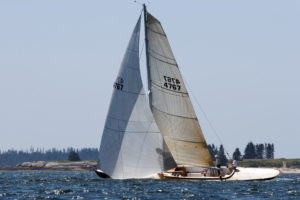
What a more efficient rig means: This is Ginger, with an unreefed main and Code Zero reacher doing ten knots. Note utter lack of panic among the crew of exactly two.
How deep and how efficient, you ask? Ah, those are good questions. And they get answered by looking at the whole picture along with rig and sails. Remember, we like that larger, slightly taller flat-top main sail for the Cal 40. Frankly, for any boat. Let’s consider that modern sail plan brings dynamics that many sailors may not always realize beyond the pocket book discussion, or beyond the threatening ‘looks’ of that modern square top main sail.
- The rig we suggest requires heavily swept spreaders that bring the shrouds out to the rail. That creates a perfect load situation that reduces all kinds of stresses on the hull and internal structure.
- By going to more sail area, you might think the boat would experience more heeling forces, but that is mis-leading. All things equal, going to a lighter carbon rig would reduce weight aloft and move the vertical center of gravity downward, and that translates into a lighter, stiffer boat and a higher righting moment. It’s a sound solutions, and it’s the equivalent of having a few crew hiking out on the rail. That is the difference-maker for safety and performance — important to single- and double-handed sailing.
- That airplane-wing sail shape is lift/drag game-changer — broad shape at the top of the rig drastically reduces the massive drag by training the air flow to something steady. A pointy Marconi main produces a cluster of vortex and turbulence issues, there is no clean laminar flow, and results in substantial drag up the top one-third of the sail plan. (Yes, Virginia a big portion of most every sail you see is nearly useless). That square-top main cleans up all that messy air and reduces overall drag. This makes that canvass more effective, actually reducing heeling and the net effect is more driving power, wider sailing grooves and less foolishness in overpowered conditions.
Essentially, the rig we like creates a positive feedback loop for efficiency and stability. And it does it in one fell swoop.
The Bottom Line
Admittedly, this is a top-of-the-line reboot aimed at the passionate Cal 40 sailor with resources. And we certainly could shave out about $100,000, if we left out interior and motor upgrades. And probably get another $50,000 to $75,000 out of the build if several were built at once. But assuming you find a shell Cal 40 stripped out and ready to go, like this one for $15,000, this project is going to cost about $350,000 – $375,000 with a quality domestic builder.
Or about in line with a new build, for a moderate custom boat.
That led us to ask — all holds barred — what would an all-new Cal 40-inspired design be? And, how might that new boat compare to this reworked boat?
Introducing The Solo 38 Performance
If the brief is to update a classic from the 1960’s, any sort of update brings it into the modern idiom. So our refreshed ground-up Cal 40-inspired design would be a welcome departure from our bread and butter Spirit-of-Tradition vessels.
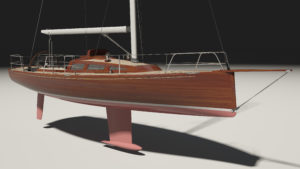
The Solo 38P: Clean lines, like the Cal 40, but upgraded all-modern hull, keel and rigging.
Take a look at the Solo 38 Performance pictured to the right.
Originally conceived for day use on Lake Michigan, with an eye towards single-handing the Chicago-Mackinac race, we see the Solo as a high-test cafe racer. Note the bright-work joinery in the cabin structure and hull topsides and how streamlined the boat is. We tricked her out with modest push-button power-assisted winch functionality, with sheet and halyards leads hidden. Rules may preclude that in some races.
Like the Cal 40, Solo 38 P is a light, slightly toned-down racing yacht, with a conservative draft and a punchy sail plan that promises lively sailing on America’s lakes, great and small. Also like Lapworth’s designs, we wanted to keep her relatively small, with amenities below simple and about right for an overnight stay. There is a lightly appointed galley, a decent head and two generous quarter-berths. It’s all about easy accommodation for two.
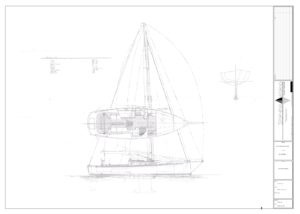
The detail drawings show a Cal 40 inspiration: Simple, spare, light on systems. All speed and fun for shorthanded racing and cruising.
Here are the basic specs. Click Here For Full Details of Solo 38P:
- LOA: 43 ft – 3 in
- LOD: 38 ft – 8 in
- LWL: 36 ft – 0 in
- Beam: 11 ft – 9 in
- Draft: 6 ft – 9 in
- Displacement: 10,000 lbs
- Sail Area: 725 sq. ft.
- SA/D Ratio: 25
- D/L Ratio: 102
- Power: tbd
How much to build, you say?
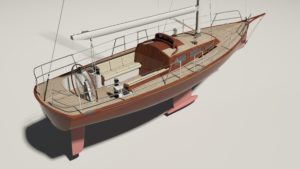
$435K for new Or $375K for a full-on Cal 40 reboot? You decide.
Funny you should ask! Because, our friend, Jim Betts, at James Betts Enterprises, that does business as Betts Boats, in Anacortes, WA, was kind enough to bake up a ballpark price for us. He says, if we lose all that varnish and go no-frills, we’re looking at base price of $435,000 for composite carbon/foam construction. Pretty cheap for a true one-off vessel dialed to be exactly what the owner wants it to be. Designed to make a serious statement at the mooring and at the finish line. The Solo will also be seriously competitive in most handicaps. But as spectacular one-design fleet, these Solos would be terrific family racers. The grand kids would fight over who gets to keep it.
What then is the best way to enjoy your hard-earned money out on the water? A rebooted Cal 4040 or the fresh Solo 38 Performance, go ahead, you tell us!
That’s the fun of this job.